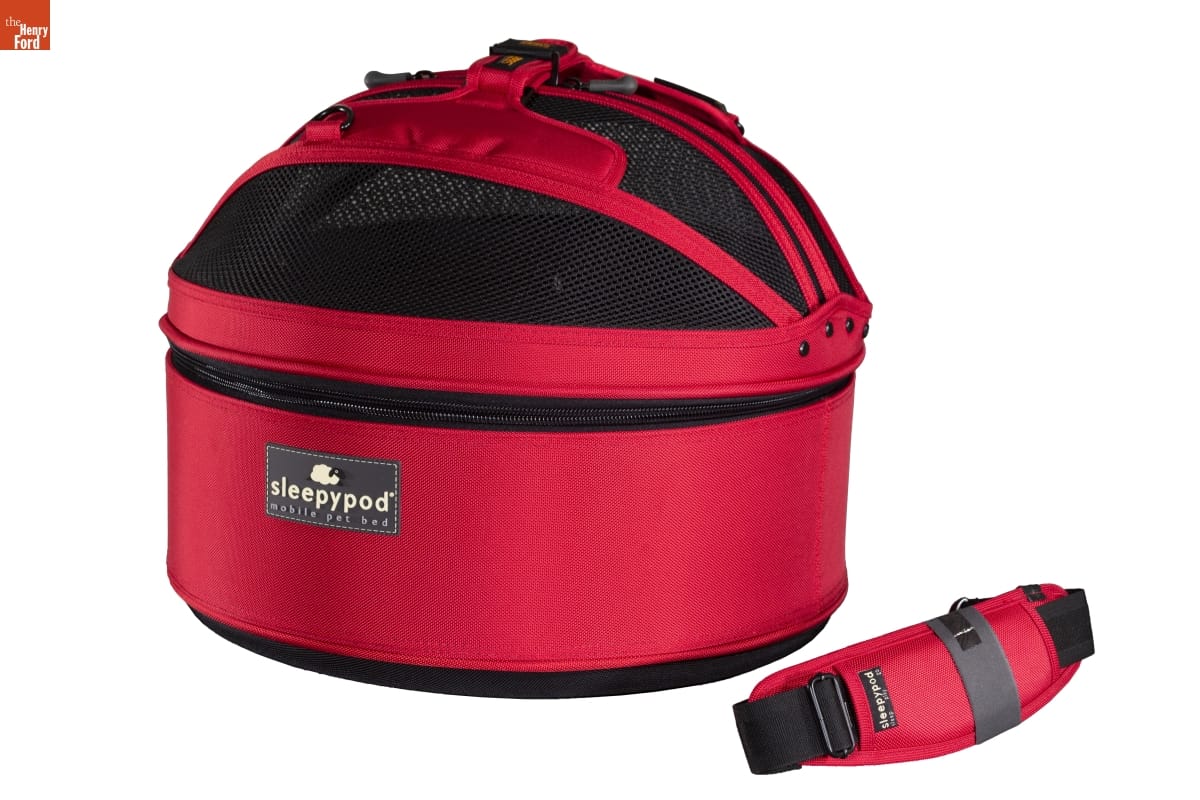Protecting Pet Passengers with Sleepypod

Sleepypod carriers are designed to protect pets while traveling inside the family car. / THF185389
Improvements in automotive safety came gradually. Dodge Brothers crashed its early cars into brick walls to evaluate their strength during the mid-1910s. Ford offered laminated safety-glass windshields on its Model A cars in the late 1920s. And Chrysler and Plymouth models featured hydraulic brakes from their introductions in 1924 and 1928, respectively. But focus on seat belt use and scientific crash testing with anthropomorphic dummies didn’t come until the 1950s.
When Ralph Nader’s book Unsafe at Any Speed, a stinging critique of automotive dangers, became a bestseller in 1965, safety at last became a serious issue. Congress passed the National Traffic and Motor Vehicle Safety Act in 1966, and seat belts, padded dashboards and standardized bumpers came to every car sold in the United States. Crash-protective child safety seats, like General Motors’ Love Seat, quickly followed. The National Highway Traffic Safety Administration issued its first child restraint requirements in 1971, and states began passing safety seat laws in 1978. But what about family pets?

Sleepypod earned positive reviews from pet-focused magazines and organizations. / THF185388
When Melony Lee couldn’t find a reliably safe way to transport her new kitten in her car, she did what any good graduate of the Art Center College of Design in Pasadena, California, would do — she set out to design her own car pet carrier. Working with fellow graduate Michael Leung, Lee researched existing carriers, noted weaknesses in their shape and construction, and created a new carrier designed to work with automobile seat belts and provide greater protection in a collision.
Lee’s cat loved the new carrier, as did Lee’s friends and fellow pet owners. Melony Lee and Michael Leung quickly realized that there was a market for their improved pet carrier. They built more than a dozen versions to refine their design into a practical, producible product for cats and dogs. They brought a third Art Center graduate, Greg Mote, aboard, and the three formed a company in 2005 to manufacture what they dubbed the Sleepypod pet carrier.
Their final version was a multitasking concoction that served as a pet bed, a carrier and a crash-resistant travel pod. The case’s interior was lined with plush bedding for comfort. The exterior and top-mounted handle were shaped to accommodate a standard three-point seat belt, keeping Sleepypod secure in a moving vehicle. When not being used for travel, the pod’s mesh dome could be unzipped and removed, allowing the lower portion to be used as a bed. This part of the design was particularly clever. By using Sleepypod as a day-to-day bed, a pet became accustomed to the carrier. Car trips in the familiar pod then became less stressful for the pet — and for the owner too.

Human-shaped dummies have been used in automotive crash tests since the 1950s. / THF256298
Determined to make their products the safest available, Sleepypod contracted with the Japan Automobile Research Institute (JARI) to test the crashworthiness of their carriers. Using the same equipment employed to test automobile safety appliances designed for people, JARI tested Sleepypod products in crashes at various speeds. If seat belts and air bags are tested using anthropomorphic crash test dummies, then how would Sleepypod test its carriers? Naturally, with crash test pets. After the JARI tests and subsequent design refinements, Sleepypod carriers were shown to effectively withstand collisions at speeds up to 30 miles per hour — the same basic standard required for child safety seats built in the United States.

MAX 2 simulates a six-pound dog. / THF185385
In 2020, Sleepypod gifted a pet carrier and two of the company’s crash test pets to The Henry Ford. Created in 2012, MAX 2 represents a smaller dog weighing six pounds. His vinyl skin is stitched together with heavy-duty thread, and his body is filled with copper and foam. The exterior material is both durable and easy to clean — suitable for the kind of rigorous testing that MAX 2 was built to endure. As his name implies, MAX 2 is not the only crash test dog of his kind. Sleepypod also created a MAX 1, representing a larger dog weighing 12 pounds.

CLEO represents a cat. Unlike MAX 2, she is equipped with a camera to provide a cat’s-eye view of tests. / THF185386
CLEO is MAX 2’s feline counterpart. Introduced in 2015, she differs from MAX 2 in one crucial respect. In place of a simulated face, CLEO is equipped with a durable digital video camera that records crash tests from the pet’s perspective. This breakthrough allowed Sleepypod officials and test technicians to see inside the Sleepypod carrier during a collision.
The Sleepypod carrier and crash test pets are compelling additions to The Henry Ford’s collections. Clearly, they help document improvements in motor vehicle safety and advances in crash test methodology. But they also wonderfully illustrate America’s changing relationship with its pets. Not too many decades ago, a pet owner might not have given the dog or cat much more than a chew toy or a ball of yarn. Today, we buy our pets everything from mail-order gourmet meals to fanciful Halloween costumes. Even the term “pet owner” is fading, replaced by the more affectionate “pet parent.” It’s only natural that we’d now want to protect our four-legged friends in the equivalent of automotive child safety seats.
MAX 2, CLEO and their Sleepypod carrier represent new innovations in pet safety and new emotions toward our favorite furry companions.
Matt Anderson is curator of transportation at The Henry Ford.

